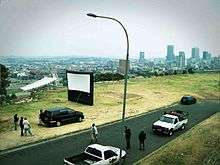Cinema of South Africa
| Cinema of South Africa (Joziwood) | |
|---|---|
 | |
| No. of screens | 857 (2010)[1] |
| • Per capita | 1.9 per 100,000 (2010)[1] |
| Main distributors |
Ster-Kinekor 38.8% Nu-Metro 35.7% Uip 21.7%[2] |
| Produced feature films (2013)[2] | |
| Total | 25 |
| Number of admissions (2011)[3] | |
| Total | 22,400,000 |
| Gross box office (2013)[2] | |
| Total | R879 million |
| National films | R98.4 million (11%) |
The cinema of South Africa, often metonymously referred to as Joziwood, refers to the films and film industry of the nation of South Africa. Although few local productions are known outside South Africa itself, many foreign films have been produced about South Africa (usually involving race relations). One exception was the film The Gods Must Be Crazy in 1980, set in the Kalahari. This is about how life in a traditional community of Bushmen is changed when a Coke bottle, thrown out of an aeroplane, suddenly lands from the sky. The late Jamie Uys, who wrote and directed The Gods Must Be Crazy, also had success overseas in the 1970s with his films Funny People and Funny People II, similar to the TV series Candid Camera in the US. Leon Schuster's You Must Be Joking! films are in the same genre, and hugely popular among South Africans.
Arguably, the most high-profile film portraying South Africa in recent years was District 9. Directed by Neill Blomkamp, a native South African, and produced by Peter Jackson, the action/science-fiction film depicts a sub-class of alien refugees forced to live in the slums of Johannesburg in what many saw as a creative allegory for apartheid. The film was a critical and commercial success worldwide, and was nominated for Best Picture at the 82nd Academy Awards.
Other notable exceptions are the film Tsotsi, which won the Academy Award for Foreign Language Film at the 78th Academy Awards in 2006 as well as U-Carmen e-Khayelitsha, which won the Golden Bear at the 2005 Berlin International Film Festival.
Silent Era

| Part of a series on the |
| Culture of South Africa |
|---|
 |
| History |
| People |
| Cuisine |
|
Festivals |
| Religion |
| Art |
|
Music and performing arts |
| Sport |
|
Monuments |
|
| Cinema of South Africa |
|---|
 |
| List of South African films |
| pre 1910 |
| 1910s |
| 1920s |
| 1930s |
| 1940s |
| 1950s |
| 1960s |
| 1970s |
| 1980s |
| 1990s |
| 2000s |
| 2010s |
| By language |
| Afrikaans |
The first film studio in South Africa, Killarney Film Studios, was established in 1915 in Johannesburg.
During the 1910s and 1920s, many South African films were made in or around Durban. These films often made use of the dramatic scenery available in rural KwaZulu-Natal, particularly the Drakensberg region. KwaZulu-Natal also served as the appropriate location for historical films such as De Voortrekkers (1916) and The Symbol of Sacrifice (1918). American filmmaker Lorimer Johnston directed several films in the area in the late 1910s which starred American actresses Edna Flugrath and Caroline Frances Cooke. Despite the participation of Johnson, Flugrath and Cooke, these were South African productions featuring local actors and stories.
Sound Era
Sarie Marais, the first Afrikaans-language sound film, was released in 1931. Subsequent sound releases such as Die Wildsboudjie (1948), a 1949 Sarie Marais remake, and Daar doer in die bosveld (1950) continued to cater primarily to white, Afrikaans-speaking audiences.
The 1950s saw an increased use of South African locations and talent by international filmmakers. British co-productions like Coast of Skeletons (1956) and American co-productions like The Cape Town Affair (1967) reflected the a growing trend of shooting in real locations, rather than using backlots.
The 4 major South African film distributors
Listed alongside each distributor are the studios they represent:
- Nu Metro: Paramount Pictures, Warner Bros., New Line Cinema, Bollywood Films, Miramax Films, Universal Pictures (video), DreamWorks SKG, DreamWorks Animation SKG.
- Ster Kinekor: PolyGram Filmed Entertainment, Focus Features, Walt Disney Pictures, Columbia Pictures
- United International Pictures: Universal Pictures (theatrical)
- Next Entertainment: 20th Century Fox
See also
References
- 1 2 "Table 8: Cinema Infrastructure – Capacity". UNESCO Institute for Statistics. Retrieved 5 November 2013.
- 1 2 3 "Box Office Report: South Africa (January – December 2013)" (PDF). National Film and Video Foundation South Africa. Retrieved 14 August 2014.
- ↑ "Table 11: Exhibition – Admissions & Gross Box Office (GBO)". UNESCO Institute for Statistics. Retrieved 5 November 2013.
External links
| Wikimedia Commons has media related to Cinema of South Africa. |
- The Latest News, Job Offers and Opportunities in the South African Film Industry
- South African movie website
- South Africa's film industry Focus on the industry – SouthAfrica.info
- African Media Program Comprehensive database of African media
- Timeline: 1895–2003 A History of the South African Film Industry
- The South African Movie Database Showcasing the South African industry
- The Callsheet Newspaper Monthly South African film industry trade publication
 This film-related list is incomplete; you can help by expanding it.
This film-related list is incomplete; you can help by expanding it.